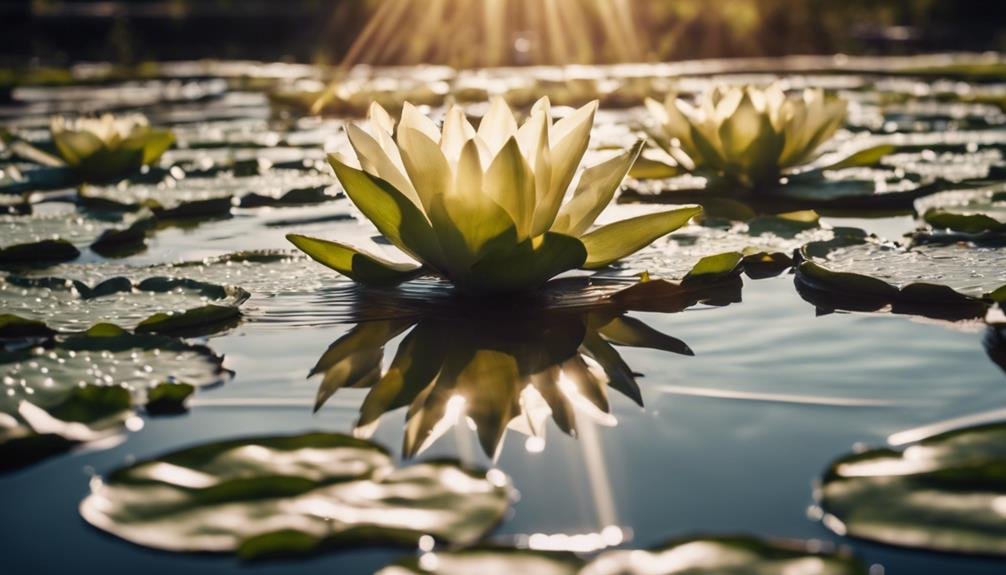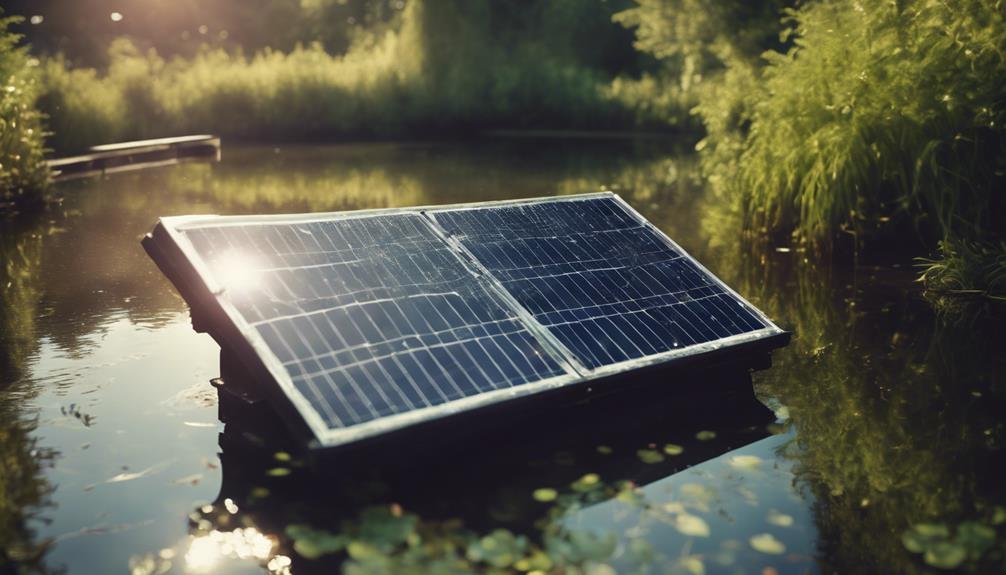We rely on solar-powered heaters to maintain optimal temperatures in ponds, ensuring a healthy environment for aquatic life. These innovative units utilize solar energy, reducing both our carbon footprint and energy expenses.
By positioning them close to the water's surface and selecting the right size for the pond's volume, we guarantee effective heating. Regular upkeep, such as cleaning and inspecting connections, is crucial to ensuring top performance.
Solar heaters play a vital role in sustaining a balanced ecosystem by providing consistent and comfortable water temperatures necessary for the well-being of aquatic species. Their minimal environmental impact and long-term cost savings make them a popular choice among pond owners.
This is just the tip of the iceberg when it comes to the benefits they offer.
Pond Temperature Regulation
Maintaining the right water temperature is essential for the health of aquatic life in ponds. Regulating the temperature is key to ensuring a thriving pond ecosystem. Water temperature impacts oxygen levels, metabolic rates, and the overall well-being of plants and animals.
Ponds can experience temperature changes due to seasons and weather conditions. In winter, water temperatures can drop, causing stress and harm to some species. On the other hand, hot summer days can lead to high temperatures, promoting algal blooms and reducing oxygen levels.
To keep the water temperature stable, solar-powered heaters can be used. These devices use solar energy to warm the water, preventing freezing in winter and overheating in summer.
Solar Power Advantages
When utilizing solar power for pond heating, we tap into a renewable energy source that offers numerous environmental and practical benefits. Solar energy is both clean and sustainable, reducing our dependence on fossil fuels and lowering our carbon footprint. Moreover, solar-powered heaters for ponds necessitate minimal upkeep, resulting in substantial long-term savings compared to conventional heating systems.
The advantages of using solar-powered heaters for ponds are noteworthy. Firstly, they're environmentally friendly as they produce no greenhouse gas emissions, aligning with eco-conscious practices. Secondly, they're cost-effective in the long run, as once the initial investment is made, the energy from the sun is essentially free.
Furthermore, these heaters are low maintenance due to their simple design with few moving parts, reducing the need for frequent repairs or replacements. Additionally, solar heaters are versatile and can be easily integrated into various pond configurations, offering flexibility in installation and design.
In essence, opting for solar-powered heaters for ponds not only promotes sustainability but also provides cost savings and efficiency in pond heating.
Heater Installation Process

When setting up a solar-powered heater for our pond, it's crucial to choose a spot that gets plenty of sunlight and allows for easy maintenance access.
We also need to consider the heater's energy needs and ensure it's the right size for our pond's size and the temperature we want to maintain.
Placement Location
Choosing the right spot for your solar pond heater is crucial for optimal performance. For the best results, place the heater near the water's surface in a sunny area without any obstructions. Here are some key factors to consider when deciding on the placement:
- Sunlight exposure is essential for the heater to work efficiently, so make sure to choose a location with direct sunlight throughout the day.
- It's recommended to position the heater as close to the pond as possible, ideally within a few feet, to maximize heat transfer and effectiveness.
- Shielding the heater from strong winds can help it retain heat better and prevent any potential damage.
- Accessibility is also important, so choose a spot that allows for easy installation, maintenance, and removal when necessary.
Power Requirements
Once you've found the perfect spot for your solar pond heater, it's crucial to determine its power requirements. The amount of power needed depends on factors like the size of your pond, the desired water temperature, and the local climate conditions. Typically, larger ponds or colder climates will necessitate more power to keep the water comfortably warm.
To estimate the power requirements, you can refer to the following general guidelines:
- For ponds up to 1,000 gallons, a recommended power range of 100 to 300 watts is suitable.
- Ponds ranging from 1,000 to 5,000 gallons may require a power range of 300 to 800 watts.
- Larger ponds between 5,000 and 10,000 gallons might need a power range of 800 to 1,500 watts.
These figures are rough estimates, so it's essential to select a solar panel with adequate wattage to effectively operate the heater. For a more precise calculation tailored to your specific situation, it's advisable to seek guidance from a professional or the manufacturer.
Sizing Guide
Getting the right size for your solar pond heater is crucial for its efficiency and cost-effectiveness. To determine the appropriate size, consider factors like your pond's surface area, desired water temperature, local climate, and heat loss due to evaporation and wind.
For small ponds up to 1,000 gallons, a heater ranging from 100-200 watts is usually sufficient. Medium-sized ponds ranging from 1,000-5,000 gallons may require a 300-500 watt heater, while large ponds between 5,000-10,000 gallons could benefit from a 600-1,000 watt heater. If you have a pond larger than 10,000 gallons, you may need multiple heaters or a higher wattage option.
It's important to tailor your choice to your specific pond conditions and desired temperature range. Seeking advice from a professional or using an online calculator can help ensure that you select the right heater size for optimal performance and energy efficiency.
Heater Maintenance Tips
To ensure our heater operates at its best, we should make it a habit to clean it regularly. Good airflow is crucial, so it's important to keep the vents clear of any dirt or debris.
Additionally, we need to check the electrical connections often for any signs of wear or damage. By doing these simple maintenance tasks, we can prolong the life of our heater and ensure it functions efficiently.
Cleaning Frequency
Regular maintenance of solar-powered pond heaters is crucial for optimal performance and durability. It's recommended to clean the heater at least once a year, adjusting the frequency based on the pond water conditions.
Signs that indicate the need for cleaning include visible algae, debris, or mineral deposits on the heater, decreased heating efficiency, unusual noises or vibrations during operation, and corrosion on metal parts.
When cleaning the pond heater, carefully follow the manufacturer's instructions. Typically, the heater needs to be removed from the pond, scrubbed with a soft brush and mild cleaning solution, and thoroughly rinsed before reinstalling.
Proper cleaning prevents damage, ensures efficient heat transfer, and prolongs the heater's lifespan.
For effective maintenance, consider using specialized cleaning products recommended by the manufacturer. By keeping your solar-powered pond heater clean and well-maintained, you can enjoy consistent heating performance and extend its longevity.
Air Flow Access
Ensuring proper air flow around the ventilation system of the solar-powered pond heater is crucial for its efficient operation. It's essential to check regularly for any blockages that may obstruct the air intake or exhaust vents, as restricted air flow can lead to overheating and potential malfunctions.
Periodically inspect the area surrounding the heater and remove any debris, leaves, or other materials that may have accumulated. Trim back any nearby vegetation that could hinder air circulation. Additionally, ensure that the heater is positioned away from walls, fences, or other structures that could block air flow.
Maintaining adequate ventilation not only helps the heater function smoothly but also extends its lifespan. By allowing unrestricted air flow, we reduce strain on the components, minimizing the risk of premature failure or damage.
With clear vents and unobstructed air circulation, the solar-powered pond heater can operate efficiently, providing consistent warmth while conserving energy.
Electrical Connection
To ensure the solar-powered pond heater operates safely and efficiently, it's crucial to pay attention to its electrical connection. A reliable and properly functioning electrical setup is essential for the heater to work effectively. Here are some important points to consider:
Firstly, inspect the electrical cords for any signs of wear, damage, or fraying. If you notice any issues, replace the cords promptly to prevent any potential hazards.
Secondly, make sure all connections are securely tightened with no loose or exposed wires. This step is vital to avoid any electrical malfunctions or safety risks.
Additionally, if you need to use an extension cord, only use outdoor-rated extension cords that are approved for outdoor use. Follow the manufacturer's guidelines regarding the cable gauge and length to maintain optimal performance.
Lastly, it's recommended to regularly test the ground fault circuit interrupter (GFCI) to ensure it's working correctly. The GFCI helps protect against electrical shocks and should be part of your routine maintenance checks.
Energy Cost Savings

Solar-powered pond heaters offer a significant advantage in reducing energy costs compared to traditional electric heaters. By harnessing renewable solar energy, there's no need for recurring electricity bills to operate the heater. While the initial investment may be higher, the long-term savings quickly make up for it.
In addition to cost savings, solar energy is a clean and environmentally-friendly power source. By using a solar-powered pond heater, we can lessen our carbon footprint and decrease reliance on fossil fuels, aligning with our sustainability goals and commitment to preserving the planet for future generations.
It's essential to consider that the amount of energy cost savings will depend on factors like pond size, local climate, and the efficiency of the solar-powered system selected. Many homeowners and businesses have reported substantial long-term savings after transitioning to solar-powered pond heaters, making them a cost-effective and eco-friendly option for maintaining optimal water temperatures.
Environmental Impact Reduction
Implementing solar-powered pond heaters not only helps reduce energy costs but also significantly minimizes our environmental impact. By utilizing the sun's renewable energy, we can greatly decrease our reliance on fossil fuels and cut down greenhouse gas emissions. This eco-friendly solution offers numerous environmental advantages:
- Reduced carbon footprint: Solar-powered pond heaters produce no direct emissions, aiding in the fight against climate change and air pollution.
- Conservation of natural resources: Solar energy is a renewable and plentiful resource, ensuring a sustainable energy source unlike fossil fuels.
- Decreased water consumption: Solar-powered systems require minimal water usage compared to traditional heating methods.
- Promotion of a circular economy: Solar-powered heaters are designed with minimal waste production and recycling in mind, fostering a circular economy.
Aquatic Life Benefits

Installing solar-powered pond heaters is a great way to support the well-being of aquatic ecosystems by maintaining optimal water temperatures for the diverse flora and fauna that call ponds home. These innovative devices create a conducive environment for aquatic plants and animals to thrive by gently warming the water to meet their specific temperature requirements.
By providing consistent temperatures, solar heaters help prevent sudden fluctuations that can stress aquatic life. This stability protects residents from potential threats like disease, low oxygen levels, and even fatalities that can result from extreme temperature changes. Solar heaters act as a protective shield, ensuring a healthy and balanced habitat for pond inhabitants.
In addition to promoting the health of aquatic ecosystems, maintaining ideal water temperatures also supports local biodiversity. A well-balanced pond with thriving plant and animal life attracts a variety of species such as birds, amphibians, and beneficial insects, enriching the surrounding environment.
Pond Size Considerations
Proper sizing is crucial when selecting a solar-powered pond heater to ensure it effectively maintains the desired temperature range based on the pond's volume and depth. Factors such as the pond's surface area, water depth, climate, and aquatic life should be considered when choosing a solar heater.
Larger ponds will require more powerful heaters to keep consistent temperatures, while deeper ponds tend to retain heat better and may need less heating power. In colder regions, stronger heaters are necessary to counteract heat loss, especially for ponds with sensitive aquatic life that require specific temperature conditions for optimal health.
It's essential to match the solar heater's capacity to the specific requirements of your pond to ensure efficient heating and a comfortable environment for your aquatic inhabitants.
Heater Placement Strategies

To maximize the efficiency of a solar-powered pond heater, strategic placement is key. Position the heater in a spot that receives direct sunlight throughout the day to ensure the solar panels can harness ample energy for heating the water effectively.
It's also advisable to place the heater near the surface of the pond since heat dissipates more rapidly in deeper waters.
For larger ponds, using multiple smaller heaters is often more effective than a single large unit. By dispersing these heaters evenly around the perimeter of the pond, you can ensure uniform heat distribution. Be sure to space them out evenly to prevent heat from being concentrated in one area.
Consider the layout of the pond and any potential obstacles like overhanging trees or structures that could cast shadows on the heaters. Shaded areas can significantly reduce the solar panels' exposure, impacting the heaters' performance negatively. By strategically avoiding these shaded spots, you can optimize the solar energy absorption of the heaters.
For larger ponds, consider utilizing multiple smaller solar-powered pond heaters placed strategically around the perimeter to ensure even heat distribution.
Avoid shaded areas caused by trees or structures to maximize the heaters' exposure to sunlight. By following these placement strategies, you can make the most of your solar-powered pond heater's heating capabilities.
Conclusion
Harnessing solar power to heat our ponds not only cuts energy costs but also helps the environment. Installing and maintaining solar-powered heaters properly will ensure our aquatic ecosystems thrive, striking a balance between technology and nature.
This shift mirrors the scientific progress of the Renaissance era, blending modern innovation with the wonders of the natural world.

